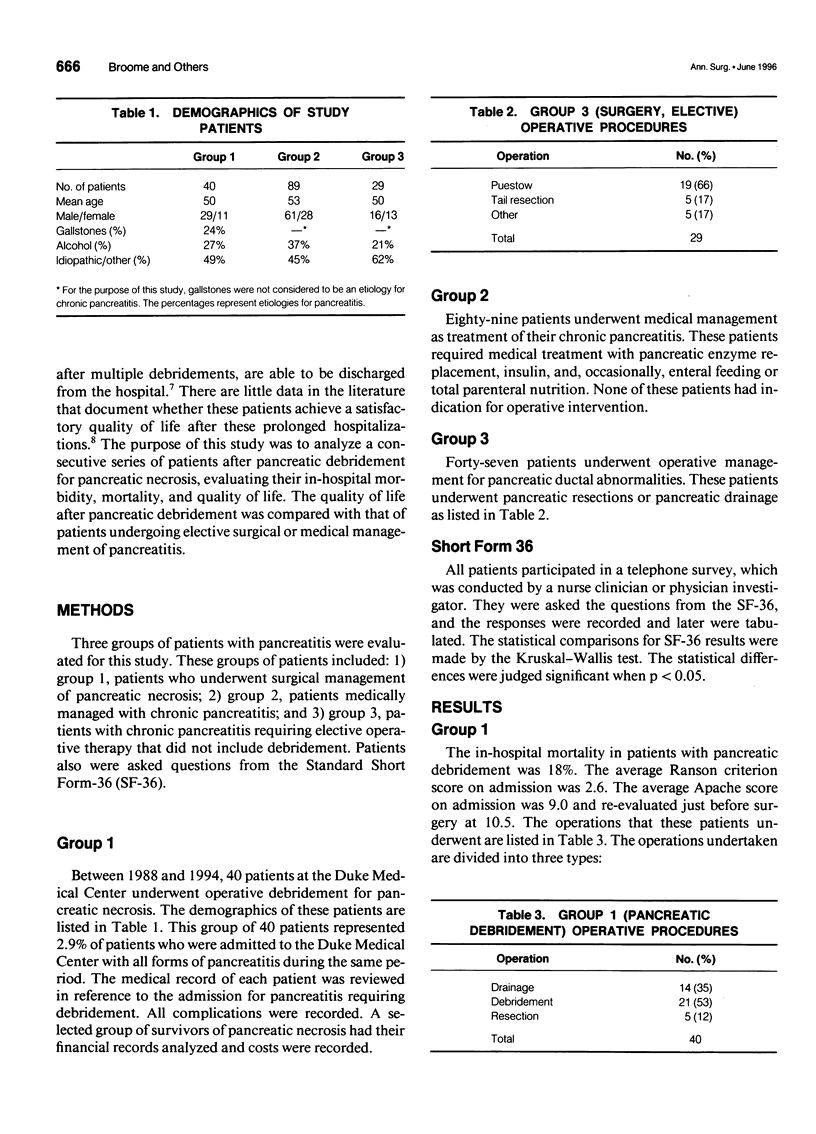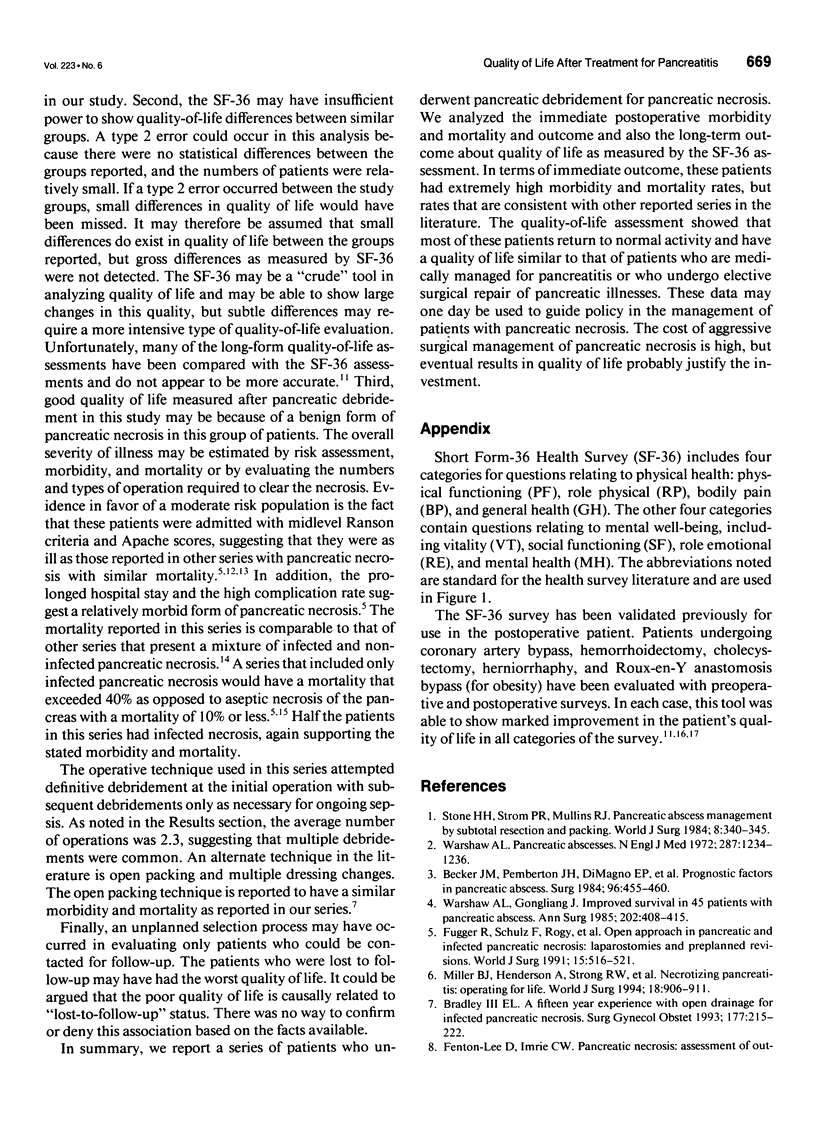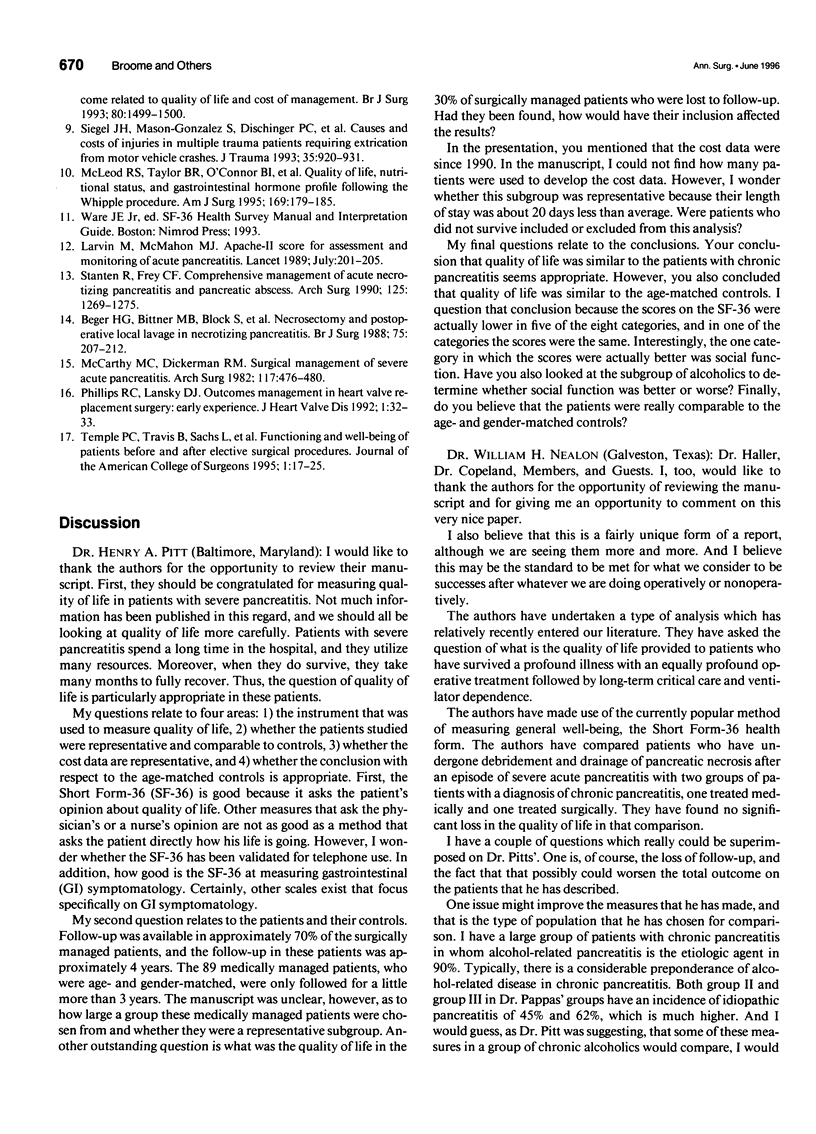Abstract
OBJECTIVE: The authors evaluated the morbidity, mortality, and quality of life after pancreatic debridement for necrosis and compared these values to those for quality of life after elective medical and surgical management for chronic pancreatitis. SUMMARY BACKGROUND DATA: Quality of life after pancreatic debridement for necrosis has received little attention. Although quality of life after other pancreatic surgery has been evaluated and is though to be good, management of patients with pancreatic necrosis can be labor intensive and require extraordinary resources. Therefore, further evaluation of the quality of life achieved after treatment is appropriate. METHODS: Forty patients (group 1) underwent operative debridement for necrosis between 1986 and 1994. Medical records of these patients were reviewed for morbidity, mortality, and in-hospital costs. Follow-up of quality of life was assessed by the Short Form-36 Health Survey. Patients in group 2 (n = 89) underwent medical management of chronic pancreatitis. Group 3 included 47 patients who underwent elective operations for ductal abnormalities. The Short Form-36 Health Surveys were administered to all three groups and compared statistically. RESULTS: Mortality and morbidity from pancreatic debridement was 18% and 77%, respectively. Quality-of-life evaluations in groups 1 through 3 and age-matched controls were statistically similar. CONCLUSIONS: Pancreatic debridement for necrosis requires intense application of resources and is associated with a high mortality and morbidity. Long-term follow-up shows good quality of life for patients who survive this morbid disease. This study supports the continued aggressive approach to the management of pancreatic necrosis, given that long-term outcome about quality of life is good.
Full text
PDF





Selected References
These references are in PubMed. This may not be the complete list of references from this article.
- Becker J. M., Pemberton J. H., DiMagno E. P., Ilstrup D. M., McIlrath D. C., Dozois R. R. Prognostic factors in pancreatic abscess. Surgery. 1984 Sep;96(3):455–461. [PubMed] [Google Scholar]
- Beger H. G., Büchler M., Bittner R., Block S., Nevalainen T., Roscher R. Necrosectomy and postoperative local lavage in necrotizing pancreatitis. Br J Surg. 1988 Mar;75(3):207–212. doi: 10.1002/bjs.1800750306. [DOI] [PubMed] [Google Scholar]
- Bradley E. L., 3rd A fifteen year experience with open drainage for infected pancreatic necrosis. Surg Gynecol Obstet. 1993 Sep;177(3):215–222. [PubMed] [Google Scholar]
- Carter D. C. Acute pancreatitis: the value of life. Br J Surg. 1993 Dec;80(12):1499–1500. doi: 10.1002/bjs.1800801202. [DOI] [PubMed] [Google Scholar]
- Függer R., Schulz F., Rogy M., Herbst F., Mirza D., Fritsch A. Open approach in pancreatic and infected pancreatic necrosis: laparostomies and preplanned revisions. World J Surg. 1991 Jul-Aug;15(4):516–521. doi: 10.1007/BF01675650. [DOI] [PubMed] [Google Scholar]
- Larvin M., McMahon M. J. APACHE-II score for assessment and monitoring of acute pancreatitis. Lancet. 1989 Jul 22;2(8656):201–205. doi: 10.1016/s0140-6736(89)90381-4. [DOI] [PubMed] [Google Scholar]
- McCarthy M. C., Dickerman R. M. Surgical management of severe acute pancreatitis. Arch Surg. 1982 Apr;117(4):476–480. doi: 10.1001/archsurg.1982.01380280060012. [DOI] [PubMed] [Google Scholar]
- McLeod R. S., Taylor B. R., O'Connor B. I., Greenberg G. R., Jeejeebhoy K. N., Royall D., Langer B. Quality of life, nutritional status, and gastrointestinal hormone profile following the Whipple procedure. Am J Surg. 1995 Jan;169(1):179–185. doi: 10.1016/s0002-9610(99)80129-9. [DOI] [PubMed] [Google Scholar]
- Miller B. J., Henderson A., Strong R. W., Fielding G. A., DiMarco A. M., O'Loughlin B. S. Necrotizing pancreatitis: operating for life. World J Surg. 1994 Nov-Dec;18(6):906–911. doi: 10.1007/BF00299103. [DOI] [PubMed] [Google Scholar]
- Siegel J. H., Mason-Gonzalez S., Dischinger P. C., Read K. M., Cushing B. M., Badellino M. C., Goodarzi S., Smialek J. E., Heatfield B. M., Robinson R. M. Causes and costs of injuries in multiple trauma patients requiring extrication from motor vehicle crashes. J Trauma. 1993 Dec;35(6):920–931. doi: 10.1097/00005373-199312000-00019. [DOI] [PubMed] [Google Scholar]
- Stanten R., Frey C. F. Comprehensive management of acute necrotizing pancreatitis and pancreatic abscess. Arch Surg. 1990 Oct;125(10):1269–1275. doi: 10.1001/archsurg.1990.01410220053008. [DOI] [PubMed] [Google Scholar]
- Starr A., Grunkemeier G. L. An artificial valve--a real life. J Heart Valve Dis. 1992 Sep;1(1):32–33. [PubMed] [Google Scholar]
- Stone H. H., Strom P. R., Mullins R. J. Pancreatic abscess management by subtotal resection and packing. World J Surg. 1984 Jun;8(3):340–345. doi: 10.1007/BF01655070. [DOI] [PubMed] [Google Scholar]
- Temple P. C., Travis B., Sachs L., Strasser S., Choban P., Flancbaum L. Functioning and well-being of patients before and after elective surgical procedures. J Am Coll Surg. 1995 Jul;181(1):17–25. [PubMed] [Google Scholar]
- Warshaw A. L., Jin G. L. Improved survival in 45 patients with pancreatic abscess. Ann Surg. 1985 Oct;202(4):408–417. doi: 10.1097/00000658-198510000-00002. [DOI] [PMC free article] [PubMed] [Google Scholar]
- Warshaw A. L. Pancreatic abscesses. N Engl J Med. 1972 Dec 14;287(24):1234–1236. doi: 10.1056/NEJM197212142872406. [DOI] [PubMed] [Google Scholar]


